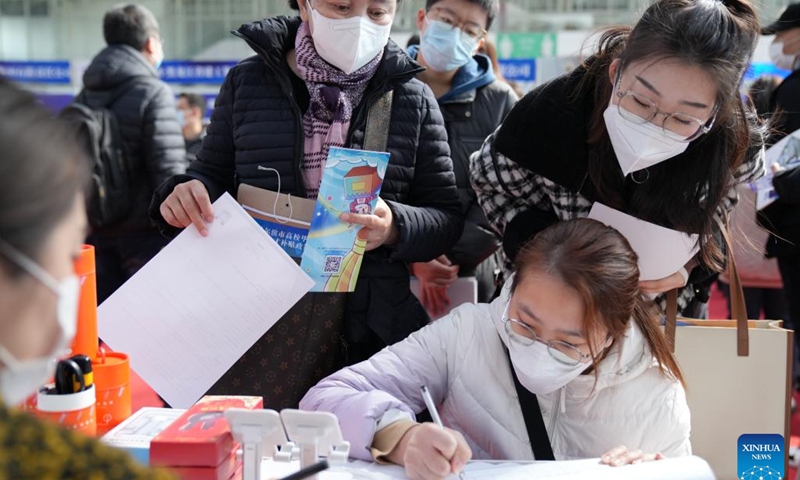
A job seeker (R front) fills in a form for employment at a job fair in Harbin, northeast China's Heilongjiang Province, March 18, 2023. More than 500 on-line and off-line recruiting events have been scheduled during this job fair, the largest of its kind in recent years held in the province, offering over 115,000 vacant positions in total. Photo: Xinhua
China's average first-half surveyed urban unemployment rate was 5.1 percent, down 0.2 percentage points year-on-year, indicating an improvement in the job market amid the overall economic recovery and support policies, official data showed on Monday.
The employment situation maintained overall stability in the first half, a spokesperson of the National Bureau of Statistics (NBS) noted on Monday.
"Economic growth, especially the continuous recovery in the labor-intensive services industry, provides support for steadily expanding employment. Policies to prioritize employment continue to produce effects, while the boom of new industries and new business models is giving a boost to new types of jobs," the spokesperson said.
Since the second quarter, the unemployment rate has stabilized at 5 percent, with wholesale and retail, catering and hospitality, and transport and other services industries seeing employment gains, NBS data showed.
"The data show that employment is improving, though structural unemployment remains," Peng Xizhe, director of the Center for Population and Development Policy Studies at Fudan University, told the Global Times on Monday.
Employment has been a priority for policymakers. A meeting of the Political Bureau of the Communist Party of China (CPC) Central Committee on May 27 stressed that promoting high-quality and sufficient employment is the new orientation and mission of the employment work on the new journey in the new era.
This year, China aims to create more than 12 million jobs in urban areas and keep the surveyed urban unemployment rate at about 5.5 percent. The government has rolled out multiple measures to ensure a robust job market this year and provide more assistance to key groups, including college graduates and migrant workers.
In June, the Ministry of Human Resources and Social Security launched a 100-day campaign with industry associations and enterprises to offer more than 10 million jobs for groups including fresh graduates to strengthen employment services.
China has invested 11.5 billion yuan ($1.58 billion) so far this year to generate 250,000 jobs for rural residents, according to the National Development and Reform Commission.
Peng said the authorities should step up policy support for private companies, especially small and medium-sized enterprises, which are a main force in creating jobs.
In addition, universities and colleges should reform their curriculums and education modes so as to nurture talent that can meet the demands of China's economic and social development and modernization, he said.
In recent years, the
artificial intelligence boom (AI) in China has led to significant increases in both job opportunities and compensation, as demand for tech talent remains high in China.
Fueled by a surge in demand as Chinese companies rush to update and develop more AI applications, monthly salaries in this field increased by an average of 5.3 percent year-on-year to 13,594 yuan in the second quarter, according to a report that Chinese job-hunting platform Zhilian Zhaopin sent to the Global Times.
In the first half, GDP grew by 5 percent year-on-year. The nationwide per capita disposable income of households was 20,733 yuan, a nominal rise of 5.4 percent year-on-year.
Wen Bin, chief economist at China Minsheng Bank, told the Global Times that the authorities are expected to roll out a new round of policies in the second half of the year to expand domestic demand and consolidate the fundamentals of the economy to support a sustained recovery and the achievement of the annual GDP growth target.
The policymakers may step up fiscal measures, for example, optimizing favorable tax policies and
increasing pledged supplementary lending to support the construction of key projects, Wen said.
He said there is a greater possibility that the central bank will cut interest rates in the second half, and it may also cut the reserve requirement ratio, depending on market liquidity.




